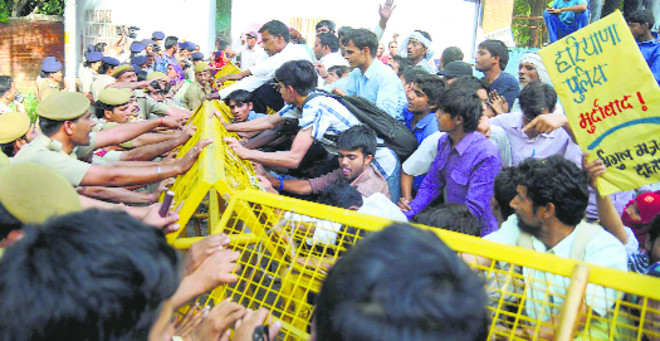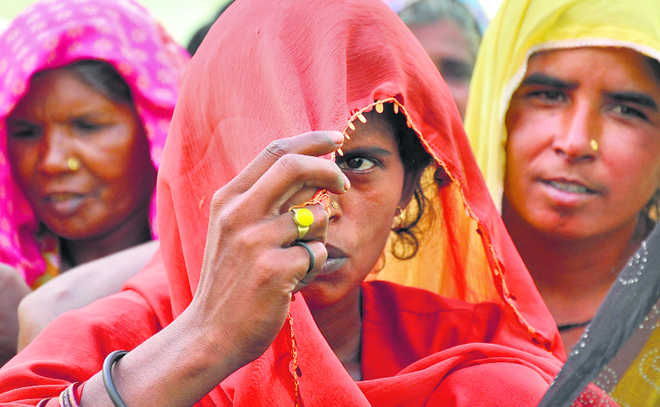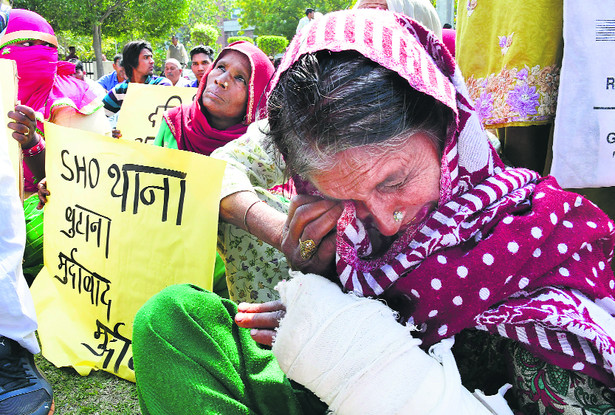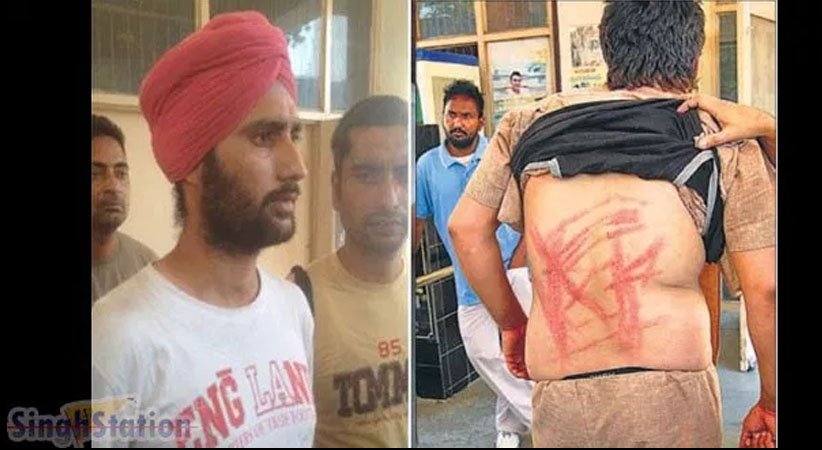NEWS & MEDIA
NEWS & MEDIA
India : Delhi High Court | Haryana Punjab | 2018-09-02Caste Violence : The Terrifying New Normal

The Mirchpur episode and the subsequent convictions reveal that the chasm between upper castes and the Scheduled Castes continues to widen. Rather, atrocities on the Dalits have been normalised.

Whither rights: Around 70 Dalit families from Mirchpur came to Delhi seeking rehabilitation.

Dalits protest against police inaction in rape cases.

Debo, a member of Dalit family of Sidhpur village of Karnal district, who was allegedly beaten up by the supporters of village Sarpanch cries.
=★=
"Instances of atrocities against the Scheduled Castes by those belonging to the dominant castes have shown no sign of abating even after 71 years of Independence.” The statement is part of the 209-page Delhi High Court judgment in response to the appeals filed by 13 convicts of the 2010 Mirchpur caste violence. Perpetrated by members of the Jat community against the Dalits in Hisar district of Haryana, the violence, as the High Court said, “is grim reminder of absence of equality, fraternity in society.”
Not only did the High Court dismiss the appeal, but also overturned the acquittal of 20 others in the case. It held them guilty of killing a Dalit and his physically-challenged daughter, among other offences.
In the gory incident, 51 persons belonging to the Balmiki community were injured and 18 homes were torched. Also, large-scale rioting and looting were witnessed. The residents had to flee the village and take shelter at a farmhouse.
All this, shockingly, happened because of a dog!
The backgrounder
A dog belonging to a Dalit barked at a group of inebriated Jat youths passing through a Dalit locality. The trivial incident led to the Mirchpur killings, as has also been observed by the Delhi High Court in its judgment. When Mirchpur happened in 2010, a magazine even published a story, Mirchpur: A dog story. More than about the canine’s natural instinct, the article was about how humans failed to recognise the basic democratic rights of the fellow citizens.
When acceptance becomes ailment
Oppression of Dalits and minorities by self-styled custodians of the majority make headlines almost on a daily basis. Labelling it as state-sponsored oppression might be jumping the gun, but, the condemnation of such inhuman acts is too little and too late — a proof of state’s reluctance to check caste-based crimes. Col Dilbag Dabas (retd), says, “We need concrete action to check crime than just kadi ninda (severe condemnation). The perpetrators perceive ninda a tacit acceptance of their heinous acts and not as deterrence. For Dalits and the targeted minorities, sadly, it remains a fait-accompli. Heinous crimes are often brushed under the carpet, and this is becoming the new normal.”
Parveen Kumar, an advocate belonging to a Scheduled Caste, says employment quotas in government sector is also one of the causes behind the occurrence of caste-based clashes and tensions. It makes upper caste envious and the anger is vented out more than often.
Dark past, bleak future
If the importance of social transformation is not realised, Haryana will continue to be dogged by such incidents in the future as well. Social scientists believe that the state’s rural society is going through a positive transitional phase. The social and cultural taboos are being challenged by those who have been at the receiving end of the prejudiced mindset for ages. However, over the years, social and cultural taboos, which otherwise amount to atrocities on the Scheduled Castes, have been accepted as the new normal by the perpetrators as well as the victims. The problem occurs when this ‘new normal’ is violated by the Dalits.
All this while, people belonging to upper-caste communities have held a superior position in the social hierarchy. And, Scheduled Caste communities have been trying to assert equality, a fundamental right. Thus, the caste cauldron requires just a spark to fire-up, leading to gory incidents like the one that occurred in Mirchpur.
Common phenomenon or aberrations
Sociologists and activists differ in views on whether such social friction is a common phenomenon or incidents like Mirchpur are, at worst, aberrations. Dr Jitender Prasad, a sociologist, maintains that everything remains hunky-dory until the Dalits are subservient to Jats in the Khadar region, Ahirs in Ahirwal and Rajputs in Bhiwani district. “They are not allowed to carry out ghurchari (procession of the groom on mare during weddings). They are supposed to back a particular candidate as per the wishes of upper castes in panchayat polls and even Assembly and Lok Sabha elections. Whenever they challenge the set norms, all hell breaks loose”, Prasad says.
Prof Sanjeev Kumar of Guru Jambheshwar University of Science and Technology says that though there has been inter-dependence between the land-holding community, which is the upper caste, and the landless class i.e. the oppressed community, the fault line exists between the two segments. “A social gap persists among the communities of the village. The upper castes are not comfortable with the elimination of this chasm.”
The middle class also feels that people who used to or are working in their fields are below them by virtue of their caste. On the other hand, the Dalits are aware of their Fundamental Rights like never before.
CB Singh Sheoran, who writes on the social evils of Haryana, negates any scope of mobility in our social set up. “Whenever the dominance of upper caste is challenged, it leads to consternation. Such consternation obviously manifests at some point if not tackled sensitively by our society.” Incidents like Mirchpur, he says, are historical aberrations.
According to Krishan Swaroop Gorakhpuria, a panchayati raj activist, the political relevance of the caste issue — Jat or non-Jat — has gained ground in Haryana and that has led to fragmentation of society. “We need social bodies to work on the field to make people from varying castes share a platform on social, political and economic issues. Khap panchayats are dominated by Jats, and thus lack credibility. Their functioning should be revised to gain confidence of people across the castes,” adds Swaroop. Equally important is to rein in miscreants who try to fuel Mirchpur-like incidents. The convicted jats in the Mirchpur case also seem to have realised that there is little reaction from other Jat groups to the Delhi High Court verdict.
Whose blame is it anyway
Inderjit Singh, a veteran CPI(M) leader from Haryana, says it is important to assess the factors behind escalating caste violence. The solution to the problem, he adds, lies in understanding the dynamics of socio-economic trajectory of Haryana. It should be read since its inception and three decades of neo-liberal policy dispensation, leading to mounting unemployment and deepening agrarian crisis. Inderjit maintains that some upward social mobility has been witnessed among the Dalits. This is perceived as a threat to the caste hierarchy by the upper castes, generating constant hostility. He adds that this assertion of the Dalits was seen on April 2 in the form of Bharat Bandh against the dilution of SC/ST Prevention of Atrocities Act by the apex court.
Mahabir Jaglan, professor of geography in Kurukshetra University, Kurukshetra, explains, “Haryana is a feudal society, which has not seen the light of social movement till date. Consequently, democratisation, socio-economic inclusion and modernisation hang in a limbo. It is a classic case of democracy dressed up in liberal ideas, but inside is a stifled caste-based society. Also, social institutions like khap panchayats have obstructed the flow of democratic movement in society.”
Certain studies have proved that the villages where upper castes dominate have experienced weak implementation of pro-poor policies and programmes.
Lack of education among the Dalits and more importantly upper castes has hampered socio-economic progress of the state.
As Prof Jaglan says, “Village-level studies conducted by our department at Kurukshetra University have revealed that the level of education of Jats is worse than artisans and Scheduled Castes in the state. The result is unemployment in villages, already marred by underemployment in agriculture. Economic liberalisation since the early 1990s has adversely affected the rural economy, which restricted itself to crop and animal production. In this scenario, if a Dalit educates himself to better his economic condition, he isn’t taken to kindly by the upper castes,” says he.
Flashback to Horror
- April 21, 2010: Jat youths torch houses of Dalits in Mirchpur village following a scuffle with Dalit youths. A disabled teen and her father are burnt in their house. More than 150 Dalit families flee the village and take shelter at a temple in Delhi.
- April 29: Congress leader Rahul Gandhi makes an unscheduled visit to the village to meet the victims. The visit puts the then Haryana Congress in a spot.
- August: The Haryana police make arrests across the month after it is pulled up by the Supreme Court.
- Dec 8: The SC transfers the case from Hisar to Delhi to ensure a fair trial.
- Dec 23: Additional Sessions Judge Kamini Lau asks the government to appoint special public prosecutor to conduct the trial.
- Jan 9, 2011: Court orders transfer of the accused to Tihar from a Hisar jail. A total of 98 accused are shifted. Out of 103, five are juveniles. One is out on bail.
- Jan 15: The Jat community, led by Sarv Khap Sarv Jatia Mahapanchayat, sit on dharna and block the Delhi-Ferozepur rail section in Jind in protest against the transfer of the case.
- Jan 20: The state government decides to hand over the investigation to the CBI.
- Feb 1: Court orders deployment of the CRPF at Mirchpur to protect witnesses.
- Feb 10: Court asks chief secretaries of Delhi and Haryana to ensure transportation and stay of witnesses here.
- Mar 10: Trial court passes order on charge against 97 persons.
- Sept 24: Trial court convicts 15, acquits 82 persons.
- Oct 31: Three convicts get life sentence, five persons are awarded a five-year jail while the remaining seven are released on probation.
- Aug 24: The high court upholds conviction and sentence of 13 convicts, reverses acquittal of 20 and convicts them.
The long list of oppressed
Mob torches homes in Gohana
Armed with spears, petrol and kerosene oil, a mob of about 1,500 to 2,000 Jats went about burning down houses. At the receiving end was a particular Dalit community in Gohana. The incident happened after a Jat youth died in a scuffle with Dalit boys.
Five lynched in Dulina
A violent mob lynched five SC men on suspicion of them being cow slaughterers. The incident took place in October 2002. The victims were dragged from the police post at Dulina village in Jhajjar district. The mob also set a four-wheeler, which it thought was used to hide the skinning of the cow, on fire.
Social boycott in Bhagana
In April 2012, Hisar’s Bhagana village saw tension between Jats and Dalits. The panchayat administration constructed a wall to block access to a few Dalit houses as a solution to a dispute over shaamlat (common) land. The panchayat later socially boycotted the Dalits, forcing several families to leave the village.
Mistaken for poacher, lynched
In May 2014, a Dalit man was lynched and another critically injured by members of the Bishnoi community. Rajbir (40) and Ram Avtar (26) of Gangwa village were on their way to Hisar’s Kalwas village to enquire about fodder prices. They were waylaid by four men, who claimed they were poachers. The youths tied the hands of the two men and beat them up with iron rods.
House set afire, two kids charred
Two children of a Dalit family were burnt alive and their parents suffered injuries after a few upper caste persons set their house on fire at Sunped village in Faridabad district in October 2015. An old enmity between the Dalit and a Rajput family was the reason behind the attack.
Dispute over house, five attacked
Five persons, including a woman, from the SC community were attacked by a few upper caste men in Jhajjar’s Naya Gaon village on September 30, 2017, following a dispute over a house at Dalit basti in the village.
Ghurchari of groom stopped
A Dalit groom was forced to climb down from the horse during ‘ghurchari’. His family members were beaten up by a dozen upper caste men at Sanjarwas village in Charkhi Dadri district in April 2017. The perpetrators plea was that the Dalits were not allowed to perform the ritual.
Marriage marred by violence
Another Dalit groom was stopped from performing ghurchari by some upper caste youths in Karnal’s Sagga village in March 2017. It resulted in stone pelting, leaving a cop and several others injured.
Stopped from offering prayers in temple
A groom from Dalit community was barred from offering prayer in a temple, a day before his marriage in Kurukshetra’s Bhustala village in May 2016. Tension prevailed as Dalits resisted oppression from the Jats. The police later persuaded them to offer prayer at the Valmiki temple.
Forced to resign
In Bapora village of Bhiwani district, people from upper caste boycotted the panchayat polls in 2010 when the post of Sarpanch was reserved for an SC candidate. When a Dalit youth defied the diktat and the villagers did not allow him to work. He had to resign.
— Sushil Manav in Chandigarh— With inputs from Deepender Deswal in Hisar and Ravinder Saini in Jhajjar
The Tribune
Link to Source: https://www.tribuneindia.com/news/sunday-special/perspective/caste-violence-the-terrifying-new-normal/646245.html





